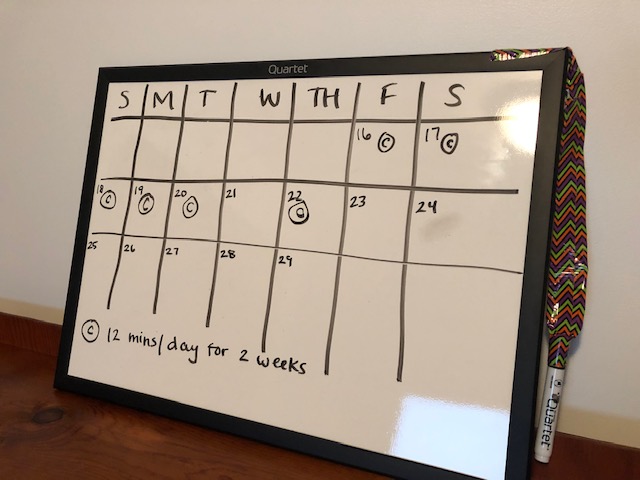There is a reason I am SO passionate about helping people harness the science of motivation and applying it to their lives.
And it isn’t just because I love drinking coffee, reading research, and writing. Although I absolutely do.
It’s because I’ve seen the incredible power of what happens when we align our goals (health-related or otherwise) with our true passions. When we take control and start living a life we are truly excited about. That, my friends, is when the real magic happens.
Making the Science of Motivation Work for You
In today’s post, I will talk about some real-world applications of motivation theory with yours truly as the test subject. You see, I’ve learned about this theory for years and been able to apply it in my life across many different life events, most recently to getting back to exercise after having a second kiddo.
I Will Cover:
- How running went from a “should” for years to now being something I truly look forward to
- Why I never exercise to burn calories or lose weight or even for “health reasons” (and I recommend you do the same)
- Methods I use to gradually work back to running after have baby #2 so that I can keep loving it (and how you can get yourself to love your exercise routine, too)
- Ways I work in strength training and core work even when I don’t want to (which is often) and how you can get yourself to do the exercises you hate
- The mindset shift that made the biggest difference for me
Disclaimer, and not a medical related one
Please understand: I do not have all of this figured out. As much I would LOVE to tell you that you just follow the steps below and you will have a perfect exercise routine for life. That, my friends, is not real life. The reality is, I still struggle to fit exercise in. My online exercise accountability group will give it to you straight. I keep showing up, but I am definitely not posting every day and sometimes not even every week.
The thing that I think I have a pretty good handle on, however, is my relationship to exercise. I approach exercise from a place of respecting myself and my body. This allows me to be flexible, not beat myself up when I have an inactive week, and keep up movement over the long-term.
If you zoom out across the past years of my life, I am still exercising on a regular basis through pregnancies, busyness and other major life stressors. If you zoom in on any particular week, I might look less active. And that’s ok. In terms of your health, habits like exercise work like compound interest – they add up over time. Therefore, it’s all about how you show up over time, and the way to do that is to have consistent internal motivation to change.
The Main Point Here
This post is not about how to craft the perfect exercise routine.
Instead, it’s about improving your relationship to exercise, how you feel and think about it. Because if you can master that, then you are set up for lifelong confidence, movement, health, and vitality over the long-term.
A Peek Into the Past
In high school, I ran track. I did hurdle events, high jump, and long jump so I literally never even made it around the track once. I was not a distance runner.
We were supposed to run 2 laps to warm-up but you would typically find me walking the second lap, or laying on the high jump mat chatting with a friend. Sorry, coach.
I didn’t enjoy distance running. It made me feel out of breath, slow, and frustrated. The three key psychological needs for long-term habit change based on Self-Determination Theory (Deci & Ryan, 2012) are shown in the picture below. I didn’t feel competent so I avoided it.

Running for Weight Loss: A Bad Combination
After high school, I decided to run a half marathon. I said I wanted to do this for the experience, but I secretly hoped it would help me lose weight. Maybe if I burned enough calories with the training it would make up for the emotional eating I was doing. I also hoped that the race would give me something positive to focus on to help me feel good about myself and stop binge eating.
As it turned out, my training partner had to quit and after a few weeks I struggled to follow the training program. I definitely did not lose any weight and did not improve my relationship with food whatsoever. The race itself was pretty fun (it finished on the boardwalk of Virginia Beach!), but I walked about half of it and by no means did this instill a love of running.
Forcing myself to sign up for this race falls into the categories of controlled motivation (specifically external and introjected; see image below), both of which is the opposite of what you want for achieving long-term habit change.
I was running to:
- lose weight (external motivation)
- finish a half-marathon (external motivation)
- try to “keep myself in check” with my emotional eating (introjected motivation)

External Motivation for Exercise and Why It’s So Detrimental
Although I actually did have some internal reasons for wanting to run (I did actually start to enjoy it some of the time, particularly the feeling I got afterwards), and the choice to run the race was completely my own (no one suggested I do it), it just wasn’t enough to overcome the external motivators.
This is often the case when you have both external and internal motivation. The “shoulds” overpower the “want to” and we get tired of the push and pull (the thought “I really should go for a run right now and the pressure to do so”) and we just stop. I see it over and over again. It’s similar to what happens when you tell kids their veggies are good for them, even if they like the veggies, they typically eat less when the external motivator is present.
This is why telling ourselves logically all the reasons we really should exercise tends to fail. It seems logical that if we just thought about our health and goals of losing weight we would want to jump up from the couch and go, but that it’s how our brains work. We are feeling beings, who sometimes think. Not thinking beings who sometimes feel.
We are motivated by feelings and desires, not shoulds and logical arguments.
Weight loss and our health as motivators, without being tied to their underlying why, is unlikely to get us up off the couch consistently.
The External Motivation Continues
After the half marathon, my motivation for running stayed the same for all of college. At my core, even though I wanted to take good care of myself and be healthy, that was not my reason for running, or trying to run. I hoped it would help me lose weight and feel more fit, but I wasn’t tied to my true reasons for wanting this.
I was sporadically forcing myself to run and did enjoy it when I did it (I truly felt great), but I could never keep it up. And I was incredibly frustrated with myself.
Because of the strong external motivation (pressuring myself to lose the weight I was gaining in college, in my case) no internal/autonomous motivation was ever truly able to take hold.
In short, running was still ultimately a chore, a should, a means to an end. Not surprisingly, it never became a consistent habit.
For the Love of Running: The Shift
Finally, while living in Philadelphia during grad school, I figured out the secret sauce (for me) to shift my motivation to internal and therefore run consistently:
Social Running Groups!
I joined two running groups in Philadelphia (shout out to Philly Runners and Fishtown Beer Runners!) that shifted my approach to running for good.
The impact of social exercise
Rain or shine on Tuesdays and Saturdays I knew my new running friends would be there, so I had to show up. Some of this motivation started as external (I have to show up because I told them I would), but I also looked forward to seeing my new friends and catching up. The community aspect was huge, which speaks to the relatedness need of the three key psychological needs (pictured above).
I also think there’s something powerful about seeing other people show up even when it’s 20 degrees and snowing out and seeing yourself do the same. We can talk all day about shifting our thinking patterns, but when you see yourself do something hard, it’s hard to not believe that you are a committed person. A true runner.
Increasing competence
As I ran more consistently, I gradually improved. My times got faster, I felt more confident and competent, and I learned to love the challenge. I started looking forward to my runs, both for the endorphin rush (intrinsic motivation) and to watch my speed gradually improve (intrinsic motivation).
Even as I type this now, a feeling of excitement comes over me that I might one day get to run and feel like that again.
Running had become part of my identity.

Sustainable Motivation to Run
I had truly shifted from running being a “should” to truly loving it. I now ran for the following reasons:
- Stress management (clearly needed in grad school)
- Endorphin rush
- Increased concentration and productivity – it helped me think clearly, get more schoolwork done, and even write my thesis and dissertation chapters when I needed to really get them done (crucial!)
- Increased energy
- The challenge of pushing myself to get faster and go harder
- Running had become part of my identity, I was “a runner” and proud of this
Michelle Segar, PhD, MPH, has a book called No Sweat, that talks about building sustainable motivation for exercise (highly recommended). She talks about exercise shifting from a chore to a gift, and then eventually to the essential fuel we need to keep us going.
Although the running group got me started, running, and then exercise as a whole had truly become my essential fuel to get me participating in my life and showing up the way I wanted to.
Enter Pregnancy

I’m insanely grateful for my children, but after two pregnancies, my body just doesn’t feel as good while running. This is due to a combination of things, including poor posture and core function, among others. Regardless of the cause, I’ve done very little running over the past 4 years and I truly miss it.
But the desire has never been lost. As I type this I feel excited by the prospect of being able to run again soon. It has never switched back to a should.
Luckily, exercise as essential fuel had been so engrained that I was able to switch relatively seamlessness to other forms of exercise as my essential fuel. I was flexible with myself and built in some accountability for myself, and got myself to enjoy a wide variety of exercise including yoga, exercise videos, and dance.
The mindset shift that made the difference
During pregnancies and the times of having little ones, I have been very flexible with my exercise. Maintaining this mindset has been key. I mostly walk, which is something I’ve already learned to love. Give me a podcast or an audiobook and some alone time and I’m a happy camper. When I do strength training videos, I find them less automatically rewarding, so sometimes I turn down the volume and listen to a podcast then, too.
Would I rather be running? Sure. Would I rather be walking 5-7 days per week instead of 2-7? Of course. But I give myself credit and feel good about the movement I’m able to do right now.
Flexibility and giving yourself credit for what you are doing is a much better motivator than self-criticism. Trust me on that one.
Exercise to Reduce Pain: Another Means to an End
Between two kids, working full-time, and building a business, I am not consistently doing my core strengthening exercises. Unfortunately, these core exercises are not particularly fun to me. Therefore, they have become an exercise that is firmly in the “should” category, thus externally motivated.
As I write this post and reflect on my journey to loving running, I realize I can (and will) use the same principles to get myself to love my core exercises (or if not love them, at least do them consistently).

Here are some ways I am shifting my motivation from external to internal so I can do my core exercises regularly and return to running:
- Made out a chart to track my progress (see picture above). This allows me to visually track my progress.
- Set an alarm for 8:30pm each night asking if I did my exercises. If I’m busy then, I hit snooze or re-set the alarm for a later time so it gets done. They only take 12 minutes.
- I remind myself that doing the 12 minutes per day gets me closer to my goal of running and feeling great again. This isn’t something I “need to do” but it’s something I want to do because it gets me closer to the person I want to be. Not only will the exercises allow me to run again, but they will also help me reduce back pain and be more active with my kids. That is, they will allow me to show up as the mom and person I want to be.
- I imagine how I feel when I’m running pain free and feeling great. This gets my energy up and reminds me of the feeling I can get in the future, which increases my drive to meet my goal.
- I also post in a group text with my friends that is focused on exercise accountability (specifically set up for this goal). I told them my goal, posted the image above, and told them that I will update them after the 14 days.
Ways to Create Long-Term Sustainable Motivation for Exercise

So how can you apply these tips for yourself?
- Don’t Pressure Yourself. I do not pressure myself to exercise. If I have a really long day, I remind myself I will probably feel better if I exercise, but guess what? Sometimes the right move is to just have a drink (probably over Zoom, sigh) with a friend or go to bed early. When I find myself saying “I should” I shift to “I want to” or “I get to.” But sometimes, I just take the day/night off and I 100% do not feel guilty about this.
- Find the Ideal Time Given the Realities of Life. I try to find times when I will enjoy it most. Right now, that’s walking at night. I used to exercise in the morning but with an unpredictable baby sleep schedule, the idea of getting up at 5:00am to make sure I get it in makes me very sleepy. So I don’t feel guilty about this at all, and I get it in in the evening. Even if it’s just walking for 15-20 minutes.
- Make it Fun. I find ways to make it more enjoyable whenever I can. If I am doing a workout DVD in my basement, I’m usually listening to a entertaining podcast at the same time. It keeps me engaged and looking forward to the exercise session because of this. Struggling with HOW to do this? I created this free 10 minute guided walk along with fun music to help you make this shift and enjoy the process!
- Reflect on Your Values. I remind myself why I value exercise and what it’s doing for me on a regular basis. I remember that doing it will help me move better without pain, and eventually run. In my head, I say, “I’m doing this because it helps me be the person I want to be.” A strong core will help me avoid back and neck pain, run around with my kids, and be the mom and partner I strive to be. If you need guidance on clarifying your values (and who doesn’t), grab my free guide on this topic. You will learn how to clarify your values and tie them directly to your health-related goals.
5 Surprising Tips for Sustainable Exercise Motivation
- Avoid doing it to lose weight. This only works as a motivator when you are actively losing weight and you can’t lose weight forever. Also, you are likely to hit plateaus and therefore when weight loss slows, your motivation for exercise will likely greatly decrease or go away altogether. Sound familiar? Do yourself a favor, and find other motivators for exercise that will stand the test of time. For more guidance tying lifestyle changes to valued directions, check out my free guide here.
- Don’t pressure yourself. Do you find yourself repeatedly saying “I really should exercise today” and feeling guilt and stress all day but then never doing it? I know I’ve been there. I definitely still do it with my 12 minutes of core exercises. Even before writing this article (doing so has helped me re-engage my motivation to do it consistently), I used to repeat to myself “it’s so boring, I don’t want to!” or “I don’t have time for that.” Now I remind myself “I want to” because it helps me get closer to goals that I really value (being pain free, running again). If you notice yourself stressing about exercise and feeling a lot of guilt, it’s time to shift from “I should” to “I want to” (and reminding yourself why you truly do).
- Start telling yourself you are “a runner” (or whatever kind of exerciser you want to be). Do you want to be a runner? Stop telling yourself you aren’t! Do you want to love exercise? Stop fixating on the fact that you don’t. There’s a fine line between acknowledging where you are honestly and fixating on it in a way that keeps you stuck. Keep an open mind and keep trying different mindsets and approaches. I bet you will surprise yourself.
- Meet yourself where you are at. Don’t push so hard that you get injured or overly frustrated. I am not pushing myself to run much now because my body isn’t there yet. For now, I walk and occasionally jog a few minutes. Just do what you can, respect your body, and it will serve you well in the long run.
- Find a social group for support. I think one of the most powerful tools to shift from external to internal motivation for any behavior is finding a supportive community. In this community, you want to look for people with similar goals, a similar approach as what you want to have (for example, not someone who is shaming themselves into exercise), and a place where you an show up and be authentically yourself, acknowledge your struggles and work on your most important goals. So whether this is an in person running group, an online group you create, or an online exercise class (there are SO many these days, many that occur in real time), go find your exercise tribe and allow them to support you in developing internal motivation.
Bonus Tip
“Run your own race, put your blinders on, and stay in your lane.”
Amy Porterfield, Digital Course Academy
I heard this recently in an online course I am taking (about building an online course, ironically). It was about business and entrepreneurship, but I think it is so applicable in so many areas.
We need to stay away from the comparison game, stay in our lane, and run our own race towards whatever goal we are working towards. I have always run with running friends who are faster than me. If I constantly was thinking about how much slower I was (which I totally did from time to time) I would have probably given up. But I had to just watch my own times and listen to my body during the runs, as I am not them.
Whatever you goals are and no matter who are looking at for inspiration or comparison, please remember that they are not you. Meet yourself where you are at, and stay in your lane.
Interested in Group Support and Accountability from the Psychology of Wellness?
I’m toying with different ideas right now, but thinking about doing something on Facebook. My hope is to create a free online community that helps people with practical suggestions but also with support in moving from external to internal motivation for the lifestyle habits they so desire, so it will last them well beyond the group. If you are interested, send me a message at info@drshawnhondorp.com so I can gauge level of interest.
If you aren’t already subscribed to my email list, please do so here so you are informed of new opportunities coming up!
References
Deci, E. L., & Ryan, R. M. (2012). Self-determination theory. In P. A. M. Van Lange, A. W. Kruglanski, & E. T. Higgins (Eds.), Handbook of theories of social psychology (p. 416–436).

I loved this post! It is so relatable. Thank you for sharing your knowledge and experiences with the world!
Thank you so much! I appreciate the feedback! Glad you found it relatable!